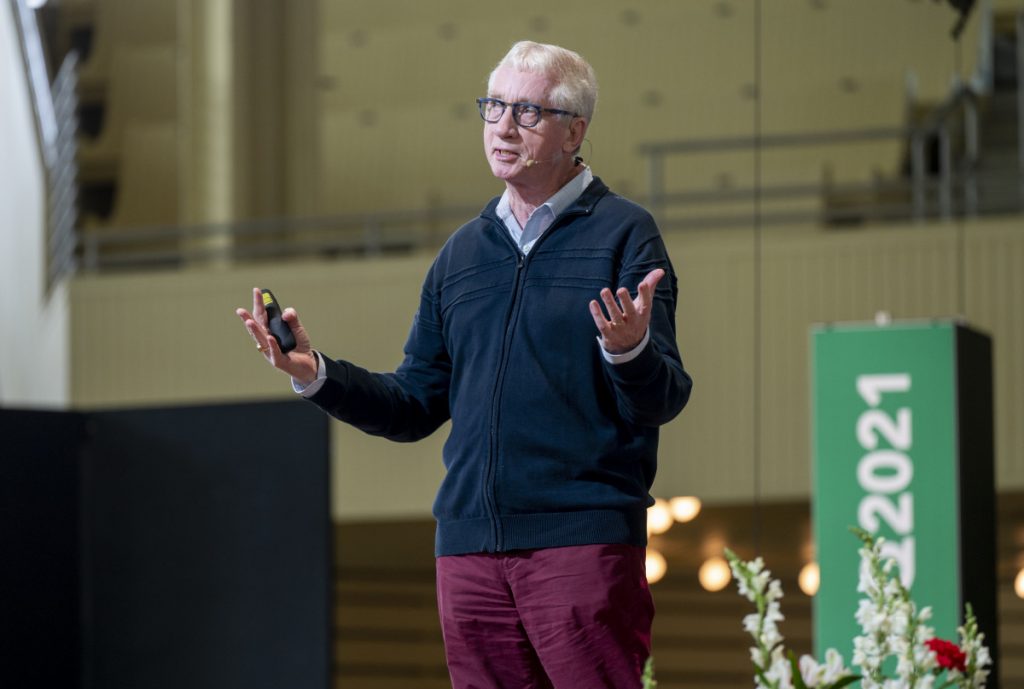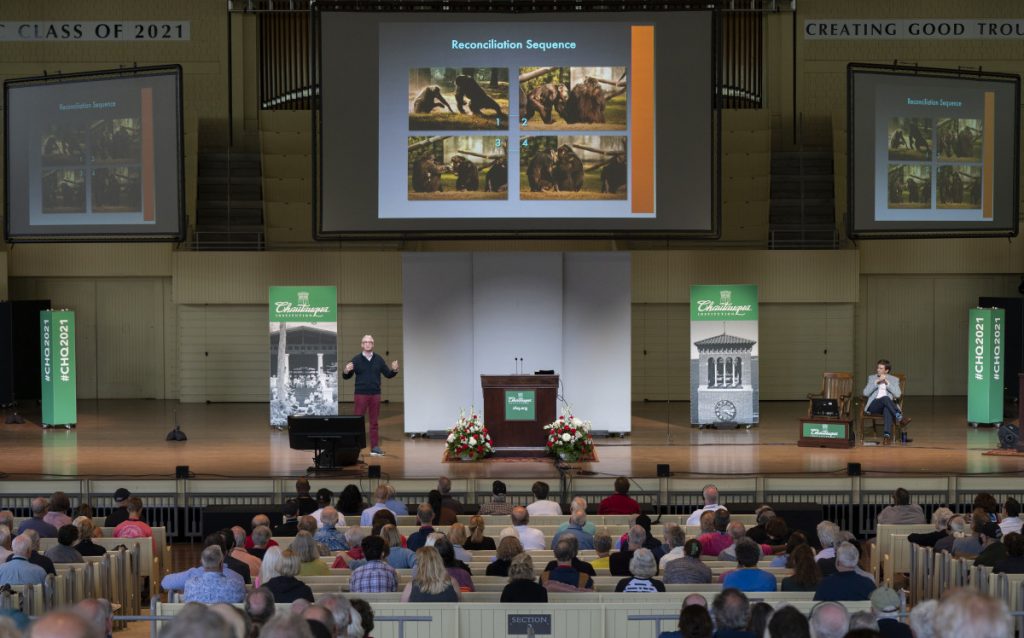NICK DANLAG – STAFF WRITER

Human faces aren’t much different from our distant cousins. Apes have similar facial muscles, able to make even the most subtle expressions that people do. This is why, as primatologist and ethnologist Frans de Waal said, humans are basically apes.
Society was not always willing to accept this fact. Charles Darwin wrote a book, The Expression of the Emotions in Man and Animals, comparing the expression of man to apes, and it was the only book of his that did not get reprinted for around 100 years.
de Waal said this is because animals were seen as more similar to machines than people, and were not capable of emotion. One researcher, Jan van Hooff, studied the human-esque smile and laugh of apes and found that apes were more likely to laugh while relaxed and playing.
de Waal then showed a video of a researcher tickling a baby chimpanzee that was on his lap.
“Young chimps and young bonobos have the same tickling spots as children,” de Waal said. “They have the same tendency of trying to push your hands away, but then waiting for them to come back.”
de Waal is the Charles Howard Candler Professor of Primate Behavior in the psychology department at Emory University in Atlanta, Georgia, and the author of Mama’s Last Hug: Animal Emotions and What They Tell Us about Ourselves. At 10:30 a.m. on Tuesday, Aug. 3 in the Amphitheater, de Waal discussed the empathic nature of social animals and the many similarities between humans and other beings, as well as his own research with bonobos, historically called pygmy chimpanzees.
Sense of humor
“If I were a young student now, I would probably start studying sense of humor in the primate,” de Waal said. “If you have a dog at home — unless it’s an old boring dog … (you know that) dogs have a sense of humor when they’re younger. … They have these playful responses to unexpected events.”
de Waal showed another video. A man performed a magic trick for an orangutan, and after the trick, the animal looked very surprised, let out an amused laugh, then rolled backward.
The next video featured a mother and son chimpanzee. The son is using the only rocks to open his nuts, so the mother starts grooming him. de Waal said chimps usually return groomings, so when her son lets go of the rocks to groom her and looks away, she gives a mischievous smile and laughs, taking the rocks for herself.
In de Waal’s own study, one of his coworkers put on a panther mask and continually popped his head out of the bushes, frightening and angering the chimps. When he stood up and took off the mask, the apes started laughing.
“At unexpected moments, that’s also what happens in humans, humor. The punchline of a joke is an unexpected ending at unexpected moments,” de Waal said. “In gorillas and chimpanzees, you may have a high-ranking male, a fully adult male, who gets chased by a baby, and has this laugh face as if he thinks it’s awfully funny to be chased by a little baby.”
And human laughter is very close to chimpanzees. Laughter makes people lose control of their bodies, making them weep, breathe hard and fall down. He then showed a video of Russian President Boris Yeltsin and President Bill Clinton. Clinton starts hysterically laughing, crying, moving around and leaning on Yeltsin, who also starts laughing and crying along with the audience.
“Laughter is a social thing, and that’s why you cannot stop laughing when you see somebody’s laughing,” de Waal said.

Conflict resolution
de Waal started his research studies with conflict resolution. Two male chimpanzees fought, met on top of a tree and embraced and kissed. He said this was the way the chimps resolved a conflict. They aren’t the only animals to have processes of moving past conflict within groups.
“They depend on each other. They depend on their relationships. They need to fix relationships when they’re broken,” de Waal said. “So in social living animals — and many of them are — you cannot just walk away from a problem; you need to fix the problem.”
After having and resolving conflict, two chimps often become more attracted or friendly to each other.
This same trend can be seen in young human children, too. de Waal said when children get into fights in the playground and reconnect afterward through play, they tend to be closer.
Adults usually reconcile their differences with conversations. One famous example is President Barack Obama and Sen. John McCain. After McCain criticized Obama publicly and the two had been disagreeing for around two years, Obama approached McCain on the Senate floor, shook his hand and made a face of regret. de Waal said this budging lip face is common in humans, and also in chimpanzees.
“It’s an expression of regret, or of losing. It’s a very common expression in humans,” de Waal said. “It’s a human male expression. It doesn’t occur in women. It’s either because women never regret anything, or because they don’t have the expression.”

Nature of empathy
Empathy has two layers, de Waal said: The emotion, or body, channel and the cognitive channel. The second requires understanding the problems of the other and is seen in humans and animals with large brains, such as dolphins, elephants and apes.
The first is more physical, such as laughter spreading through a room, or one baby’s cries making a plane full of babies cry. In humans, de Waal said research has shown this physical empathy is seen more in young girls than boys.
The contagious nature of yawning is also caused by physical empathy, which is seen in animals from dogs to fish.
“If you want to get the Nobel Prize, you discover why animals and humans yawn, because we really don’t know,” de Waal said.
In one study, chimps watched videos of other chimps yawning, which caused them to yawn. They were more likely to yawn, however, if they saw a chimp they knew yawning, and humans are the same way.
“Empathy is very biased to individuals who are familiar and similar,” de Waal said. “That has a negative side, meaning that we have a lot of trouble with empathy for individuals who are not like us; for example, different language groups, different races, different ages, different genders.”
And empathy has to be fostered in apes. In a research center in Kinshasa, Democratic Republic of the Congo, orphan chimps were often sold in local markets, and researchers brought back as many as they could to the center. These orphan chimps reconciled with other chimps half as much as ones reared by their mother.
“That fits a bit with the human data — that if you are raised in deprivation of contact, which is what happens sometimes with the orphans, you have more trouble having empathy for others,” de Waal said.
Chimps can learn later in life, and de Waal said the orphans can slowly catch up to their counterparts.

Social experiments
de Waal then showed multiple videos of experiments to see how chimps behaved when given a choice to help another chimp. One experiment showed that chimps, given the choice of a green object that would feed them and the other chimp, would more likely choose that option than the other, which would only feed themselves.
They were more likely to choose the green option if the other chimp made a fuss, but less likely if the other chimp got too obnoxious, such as slamming the cage or screeching for long periods.
And de Waal was part of the team that first learned about capuchin monkeys’ devotion to fairness.
“No one had expected this phenomena. We had not expected it, by the way,” de Waal said. “We discovered, by accident while working with capuchin monkeys, that they care about what somebody else is getting.”
His team put the capuchin monkeys in cages next to each other and gave them different food for completing a given task. The one who received less tasty food, such as cucumbers instead of grapes, would yell and often refuse to do the task.
One video, which he said was downloaded 200 million times, showed two capuchin monkeys receiving different foods. The researchers would hand them each a rock and when the animals handed them back, one would receive a grape, which the monkeys liked, and the other would receive a piece of cucumber.
As the video went on, the capuchin monkey that received a cucumber became angrier and angrier, hitting the rock on the cage, trying to rip the barrier down and throwing the cucumber back at the researcher, all while the other capuchin monkey never made a noise.
His team received a letter from a philosopher saying that animals could not have empathy, because empathy was invented during the French Revolution. de Waal believes morality is based on basic emotions.
“That’s why our moral reactions are so emotional. We get upset about morality because the emotions are involved,” de Waal said. “It’s not like it’s some sort of principle that has been formulated by some old philosophers in Paris or something. That’s not how morality works. It bases itself on these very basic emotions.”
Human children also have a similar reaction to unfairness. One mother who watched the video recreated the experiment with her young children, giving her son a cookie and her daughter half of one. The daughter immediately started crying and dropped the treat on the ground.

Mama’s last hug
Chimpanzees have both patriarchs and matriarchs. The males in charge gain their power through physical dominance in their peak years, whereas females gain power through social connections, often becoming more powerful as they get older. This is the reason Mama, the chimpanzee in de Waal’s book, was able to rule her group for around 40 years.
When Mama was dying, researcher Jan van Hooff entered her cage to say goodbye. de Waal said researchers never enter animals’ cages, especially chimpanzees, who can be three- to five-times stronger than humans.
But because Mama was dying, and van Hooff had known her for so long, he entered the cage. Mama smiled at him, and reached out and patted the back of his head. de Waal said this is a common gesture chimpanzees do to calm each other, and van Hooff was probably nervous going into the cage.
“Mama noticed, and she is the kind of figure who will immediately calm you down if you’re upset,” de Waal said. “So I think that’s what’s going on here, is that it’s not only that he’s saying goodbye to her, but that she’s calming him down.”
While people know chimps understand when other chimps die, scientists are not sure if the animals understand their own mortality.
“They sometimes don’t eat for a week or they’re very upset when somebody dies, and they know it’s irreversible. But whether they have an understanding of their own mortality — that is not something we know,” de Waal said. “I’m not 100% sure that for Mama, this was a farewell. That was a farewell for van Hooff, but maybe not for her.”
As part of the Q-and-A session, Matt Ewalt, vice president and Emily and Richard Smucker Chair for Education, asked de Waal how other chimps in her group reacted to Mama’s death.
He said that zoos in the past used to dispose of the bodies of dead animals without showing the others. They have changed that procedure for animals that show signs of understanding death, such as chimpanzees.
The researchers let the other chimps in to see Mama’s body. Some of the male ones took longer to recognize that she was dead, while females were quicker and gentler with her body.
One female, which Mama adopted and raised, was very protective of the body, not letting others near it.
“They also were completely silent,” de Waal said. “The interesting thing is, chimpanzees are not normally silent.”




